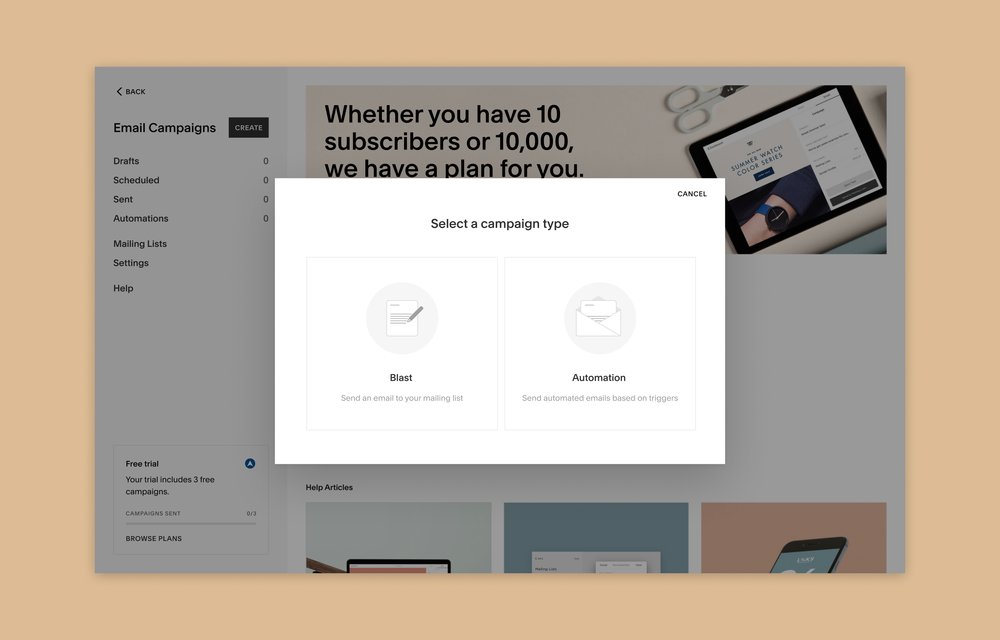Download our free workbook to help you launch your email marketing strategy.
The email you entered is invalid.
Thank you for subscribing.
By entering your email, you indicate that you have read and understood our Privacy Policy and agree to receive marketing from Squarespace.
For entrepreneurs and small business owners who are pressed for time, planning marketing efforts can feel like a heavy lift. With automated emails, you can streamline your email marketing operations and improve customer experience.
An automated email is written in advance and automatically sent when a subscriber takes a specific action. From abandoned cart reminders to thank you notes after completing a purchase, automated emails are a strategic way to deepen relationships with your customers online.
Once you've started an email list, setting up automated emails is simple. Read on to get started.
A step-by-step guide to sending automated emails
Automated emails differ from one-off emails—usually called email blasts—because they are pre-determined and only intended for users after they’ve taken a specific action on your website, like completing a purchase or signing up for your mailing list.
Here are three key elements to consider when you’re planning automated emails:
Outline your goals
Decide first what you want this email campaign to achieve, and with which audiences. You might reward your subscribers by sending a discount code or special content when they join your mailing list, recommend related products after a customer completes a purchase, or send an email checking in with subscribers after a set amount of time.
Choose one goal and focus your messaging around that, so recipients understand the purpose of your communication.
Choose a template
Most email marketing platforms offer a variety of email templates, which can be used as-is or customized. Once you select a template and format your message, it will be sent to any person who takes the specific action that triggers the automated email—no need to manually update your email content before it goes out.
See example templates for email copy
Time it right
Being thoughtful about the timing of an email is crucial. For example, do you want to send an email immediately after someone signs up for your list, or is scheduling it for the next day better? For campaigns with multiple emails, how much time does it make sense to leave in between sends?
These questions can be answered over time by testing different approaches, then diving into email analytics and seeing what the open rate or number of unsubscribes tells you about which approaches work best.
Squarespace Email Campaigns helps you with all of these key elements, giving you the opportunity to pull content and branding directly from your Squarespace website in order to easily build and schedule multiple campaigns. You can also set emails to send out based on specific actions, like based on specific purchases.
The main types of automated emails
Here are some common types of automated emails:
The welcome email
Once someone decides to sign up for your email list, it's a nice gesture to send them a welcome message. Think of this email as a friendly hello that introduces your brand to your new subscribers.
This message might:
Greet your new subscriber
Thank them for their interest in following along
Provide more information about your brand
Let them know when they will receive emails (i.e., monthly, or just when you have updates like sales or new products)
Offer a discount or a free download
You can send one welcome email, or create a series of emails for new subscribers to receive over the following days and weeks.
See welcome email templates and tips
A post-purchase email
You can set a trigger to email subscribed customers after they make a purchase, encouraging them to return to your site by offering a coupon or a recommendation for another popular product. You can’t send these emails to all buyers, however—just ones that have opted into receiving your messages.
With any automated email, reinforce your original goal with a clear call to action (CTA) button that makes it easy for readers to do what you want them to do. Keep the CTA button copy short—and be sure to check all of the links in the email before you send.
Tracking success
After sending an email campaign, the next step is to look at how the email performed. Email marketing analytics like open rate and click through rate will help you gauge which content resonates with your audience. Open rate is the percentage of people from your mailing list who opened your email, and click-through rate is the percentage of the people who opened the email that then clicked on at least one link in it.
Analytics also reveal customer patterns—for example, whether or when people unsubscribe—that can guide your strategy and email cadences.
Want more email marketing tips? Learn how to create a newsletter for your blog or business.

